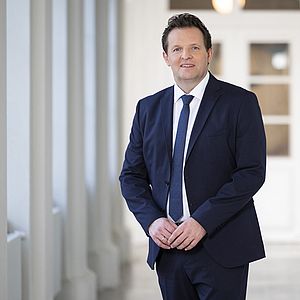From deliverance to denial
The official surrender of the local Wehrmacht units took place on 5 May 1945. The command of the US liberators sealed the end of hostilities in the Gauleiter’s meeting room. The occupying forces established their base in the New Landhaus. To counteract the symbolic impact of the Landhaus, the French military government erected the Liberation Monument facing the perpetrators’ building. For decades, no attention was paid in the Tyrolean political arena to the significance of the former Gauhaus, while the Alte Landhaus was cast as a haven of democracy and resistance against the Nazi regime.
The Nazi legacy dominated everyday work in the Landhaus. The Tyrolean government was happy to benefit from the enormous increase in the size of its premises. They disputed the criminal origins of the building and defended the actions of the Tyrolean Nazi leaders. The question of denazification was handled in the same style: Former members of the NSDAP had nothing to fear. Leading figures in the Nazi movement had to stand trial before the Austrian People’s Court. They protested their innocence and refused to accept any responsibility.
Capitulation
1. Footage of the liberation of Innsbruck and the signing of the surrender document in this room, NARA Washington
1. “Schnapps, flowers and cheers”
Jubilant crowds gave their liberators an enthusiastic welcome on 3 May 1945. The people of Innsbruck met the US troops with schnapps, flowers and cheers. The surrender document of the local Wehrmacht units was signed two days later in the conference room of the former centre of the Nazi apparatus.
Meaning
1. Entrance to the Old Landhaus, 1945, StAI
2. Occupancy certificate for the New Landhaus, August 1948, TLA
3. The flags of Austria and the occupying powers on the New Landhaus after 1948, StAI
4. Rally to mark the liberation of Austria in front of the Old Landhaus, May 1946, TLA
5. Commemorative plaque for Franz Mair on the Old Landhaus, May 1946, TLA
6. Liberation Monument in the course of construction, 1947/48, StAI
1./2./3. Not enough room
The occupying forces set up their base in the former Gauhaus. Their enormous requirements with regard to office accommodation left the Tyrolean authorities drastically short of offices for themselves. In December 1945, the French military government occupied 30 offices in the Old Landhaus, 25 rooms in the Taxispalais and almost the whole of the New Landhaus.
4./5. “Seven years of oppression”
From June 1945, new designations for the administrative buildings appeared in the files: the terms “Old Landhaus” and “New Landhaus” drew a line under the Nazi past. The Tyrolean political community sought to position the Old Landhaus as a symbol of liberation and resistance. The fallen resistance fighter Franz Mair became the human face to Tyrol’s idealised role of victim of the Nazis.
6. To those who died for the freedom of Austria
The Liberation Monument on Landhausplatz was erected by the French military as a permanent warning confronting the building of the Nazi perpetrators. The monumental character of the Landhaus architecture was made all the more apparent. The Liberation Monument was never officially unveiled. The local people disparagingly referred to it as the “French” or “Victory Monument”.
Nazi legacy
1. Report from the Tyrolean Police Authority to the Directorate General, July 1945, TLA
2. Innsbruck Police Headquarters to the Security Director for Tyrol, September 1945, TLA
3. “Hunger demonstration” in front of the Old Landhaus, November 1946, TLA
4. Police photographs of Werner Hilliges and Max Nedwed taken at Innsbruck Police Headquarters in 1948, CADLC
5. Amended plan of the Landhaus project used as evidence by the Tyrolean authorities in restitution proceedings in 1948, TLA
6. Delivery protocol for church valuables returned in January 1958, TLA
1./2. “Far from dead”
In 1945 there were ample opportunities for addressing the building’s Nazi past. The party eagle on the east facade and the “Panzerfaust” bazooka were removed. But how could Nazi convictions be erased? Adele Obermayr, member of the Landtag for the SPÖ and survivor of the Ravensbrück concentration camp, said in the October session of the Landtag in 1945 that National Socialism was “far from dead”.
3. Bitter hardship
In the first years after the end of the war, the Nazi legacy meant chaos, hunger, housing shortages and deprivation. People took to the streets to voice their anger. For the demonstrators, the same “Nazi bigwigs” were still sitting in the Landhaus. And indeed, former National Socialists were to be found all the way up the hierarchy.
4. Reichenau trial in the Paris Hall
The “Reichenau trial” started in the Paris Hall in December 1948. The accused included the two former Gestapo chiefs Werner Hilliges and Max Nedwed. Together with five other defendants, they had to answer for crimes committed in the Reichenau concentration camp. They had tortured and murdered inmates until the very end. The trial is still not anchored in the collective memory.
5. Denial
The acquisition of private properties by offering an exchange with “aryanised” real estate has an aftermath. The exchanged properties are returned to the rightful Jewish owners. In return, the Tyrolean authorities should have returned the residential properties thus acquired. Instead, they defended the criminal actions of the Gauleiter’s office. A map was presented in support of the argument that the Gauhaus ensemble was to have been located elsewhere.
6. It’s better to give than to receive
At a leisurely pace, the Tyrolean authorities returned the looted church property that had not been disposed of. The last act of restitution, to Wilten Abbey, did not take place until January 1958. This was the task of Alexander Moschen, of all people, who had received the looted property a few years earlier.
Denazification
1. Denazification caricature on an election poster in Innsbruck, 1945, TLA
2. Personnel office report on SS-Oberscharführer Heinrich Mandlez, 1939, Archive of LPD Tirol
3. Memo on the tracing, arrest and committal of Heinrich Mandlez in April 1950, Archive of LPD Tirol
4. Support for Heinrich Mandlez’ petition for pardon by Governor Alfons Weissgatterer, October 1950, TLA
5. Closure of the preliminary investigation in the Mandlez case, May 1954, TLA
6. Statement by Heinrich Mandlez in his memoirs written in the 1980s, TLA
7. Caricature of the Nuremberg Trials, 1946, “Neues Österreich”
1. “From brown to black”
The Tyrolean regional government was against a strict approach to denazification. The first elected governor, Alfons Weissgatterer, gave the lead. He had himself been a member of the NSDAP but later participated in the resistance. The majority supported his approach. However, there was also criticism. In the cartoon, the ÖVP is portrayed as the Austrian Transformation Party.
2./3./4./5./6. “To the last hour”
Denazification often followed the same pattern. Heinrich Mandlez was a member of the SS and worked as an office manager in the Landhaus. After the war he went into hiding. A warrant was issued for his arrest, but no charges were ever brought. Like many others, he could present a “Persilschein” (whitewash certificate) issued by Governor Weissgatterer. He remained convinced into old age that he had fought for the right cause during the Nazi era.
7. “He gave me the order”
Senior Nazi officials had to stand trial before an Austrian People’s Court. Their defence strategy was always the same. They portrayed themselves as mere subordinates subject to orders and denied any personal responsibility. Deputy Gauleiter Herbert Parson explained the scope of his authority with an alleged quotation from Hofer: “Parson must know everything and decide nothing.”








